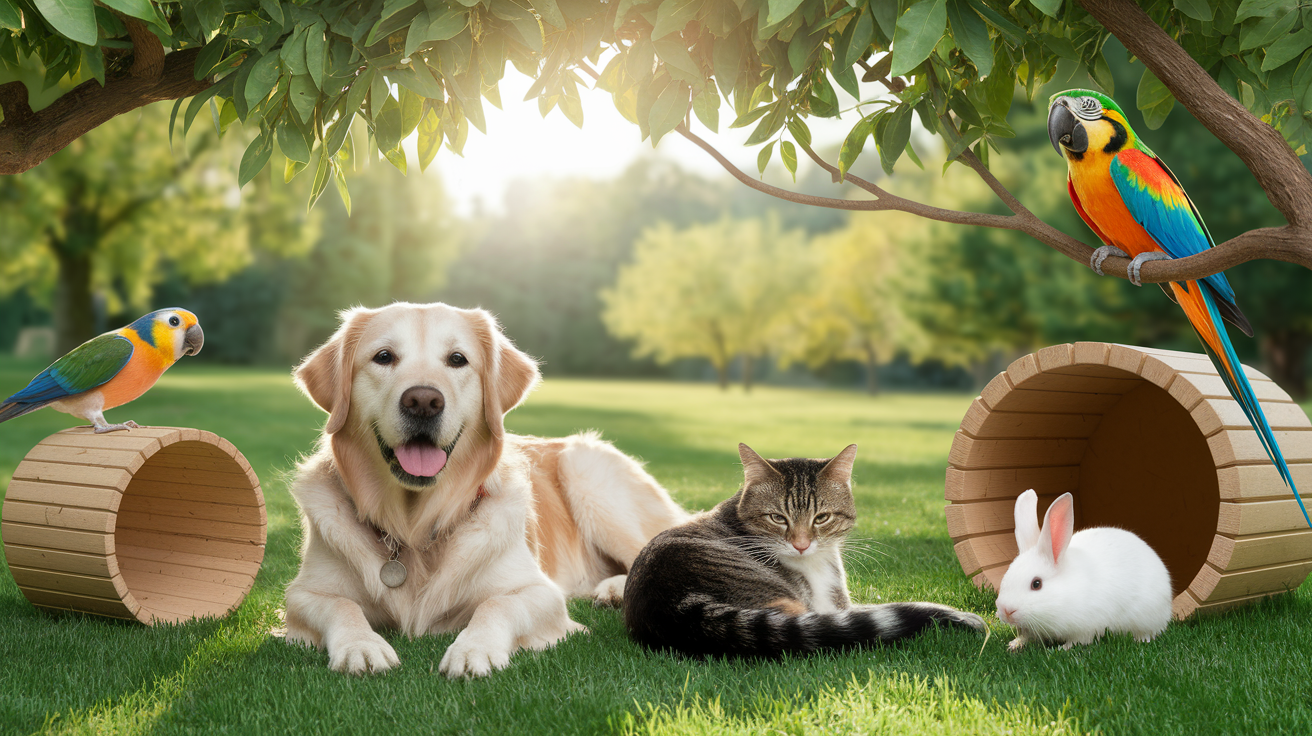Finding your perfect animal companion starts with understanding your own needs and capabilities.
Introduction to Choosing The Right Pet
I still remember the day I brought home my first pet as an adult – a rambunctious Labrador puppy who proceeded to chew through my favorite shoes, wake me at 5 AM daily, and completely upend my carefully organized apartment. Don’t get me wrong – Charlie became my best friend for 14 wonderful years, but those first few months? Complete chaos.
The truth is, many of us choose pets based on emotion rather than practicality, falling in love with fluffy faces without considering whether our living situations, schedules, or personalities align with what that animal needs. The result? Stressed pets, frustrated owners, and sometimes even heartbreaking surrenders to shelters.
But it doesn’t have to be this way. Finding your perfect animal companion starts with an honest assessment of your lifestyle, expectations, and capabilities as a pet parent. Whether you’re a busy professional, an active outdoorsy type, or someone seeking a low-maintenance friend, there’s a perfect pet match for you – and this guide will help you find them.
Choosing The Right Pet involves considering how different animals will fit into your unique circumstances.
Understanding Different Pet Types
Dogs: Man’s Best Friend (With Conditions)
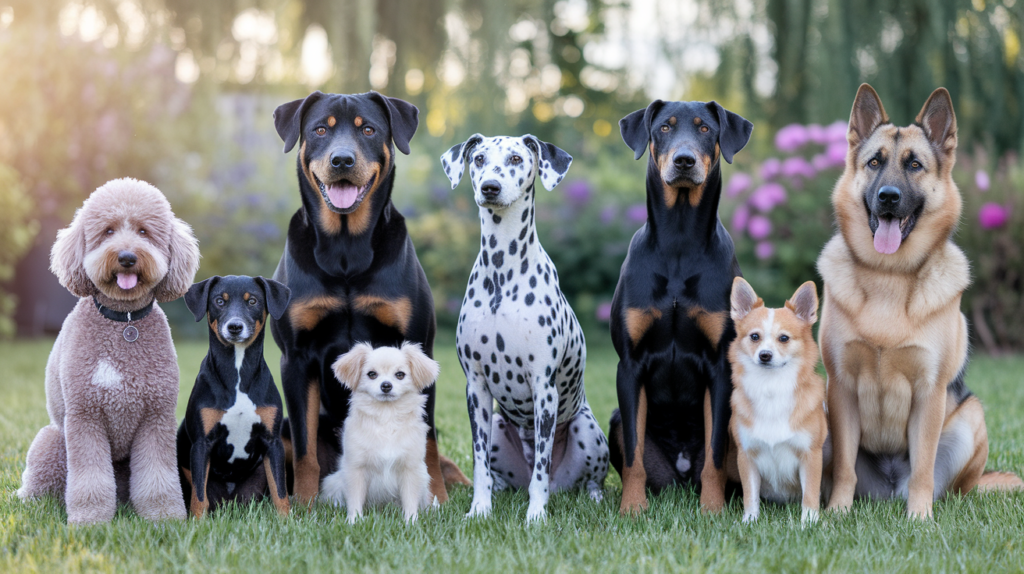
Dogs offer unparalleled companionship and loyalty, but they’re also among the most demanding pets. Here’s what to consider:
Time Commitment: Most dogs need daily walks, regular play sessions, and consistent training. Can you commit to 1-2 hours of active attention daily?
Space Requirements: While some breeds adapt to apartment living, most dogs benefit from having outdoor space to explore. Consider your living situation carefully.
Financial Investment: Between quality food, preventative veterinary care, training classes, and supplies, dogs typically cost $1,500-$2,000 in the first year, then $500-$1,000 annually thereafter.
Lifestyle Match: If you travel frequently, work long hours away from home, or prefer a pristine, quiet living space, a dog might not be your ideal match.
Quick Dog Breed Comparisons
| Breed Type | Exercise Needs | Grooming | Trainability | Good for Apartments? |
|---|---|---|---|---|
| Retrievers (Lab, Golden) | High | Moderate | High | No |
| Small Terriers | Moderate | High | Moderate | Yes |
| Brachycephalic (Bulldogs, Pugs) | Low-Moderate | Moderate | Moderate | Yes |
| Herding Dogs (Border Collie, Australian Shepherd) | Very High | Moderate | High | No |
| Companion Breeds (Bichon, Shih Tzu) | Low-Moderate | High | Moderate | Yes |
Cats: Independent But Affectionate

Cats strike a different balance than dogs, offering companionship with greater independence.
Time Commitment: While cats need daily interaction, they’re more self-sufficient. Expect to spend 20-30 minutes daily on active play and care.
Space Requirements: Cats can thrive in apartments, but they need vertical space to climb and perch. Cat trees and shelving become important.
Financial Investment: First-year costs typically run $800-$1,100, with annual costs thereafter around $300-$800.
Lifestyle Match: If you work long hours, travel occasionally, or live in a smaller space, cats often adapt better than dogs. Just remember – they’re not completely maintenance-free!
Small Mammals: Pocket-Sized Companions

Rabbits, guinea pigs, hamsters, gerbils, and rats each have unique care requirements, but share some commonalities:
Time Commitment: Daily feeding and weekly habitat cleaning, plus regular handling to maintain tameness.
Space Requirements: They need larger enclosures than pet stores often suggest, plus time outside their habitat for exercise.
Lifespan Variations: Guinea pigs and rabbits can live 5-10 years, while hamsters typically live only 2-3 years.
Financial Investment: Initial setup costs for quality housing can be $100-$300, with annual costs of $200-$500.
Lifestyle Match: Great for apartment dwellers with moderate time to invest, but not ideal “starter pets” for very young children despite popular perception.
Reptiles and Amphibians: Fascinating Low-Interaction Pets
These specialized pets require specific environmental conditions but relatively little direct interaction.
Time Commitment: Daily feeding (frequency varies by species) and regular habitat maintenance.
Technical Knowledge: You’ll need to maintain precise temperature gradients, humidity levels, and UVB lighting for most species.
Financial Investment: High startup costs ($300-$500+) for proper enclosures and equipment, moderate ongoing costs.
Lifestyle Match: Good for those fascinated by these animals who aren’t seeking cuddly interaction, and who don’t mind specialized care routines.
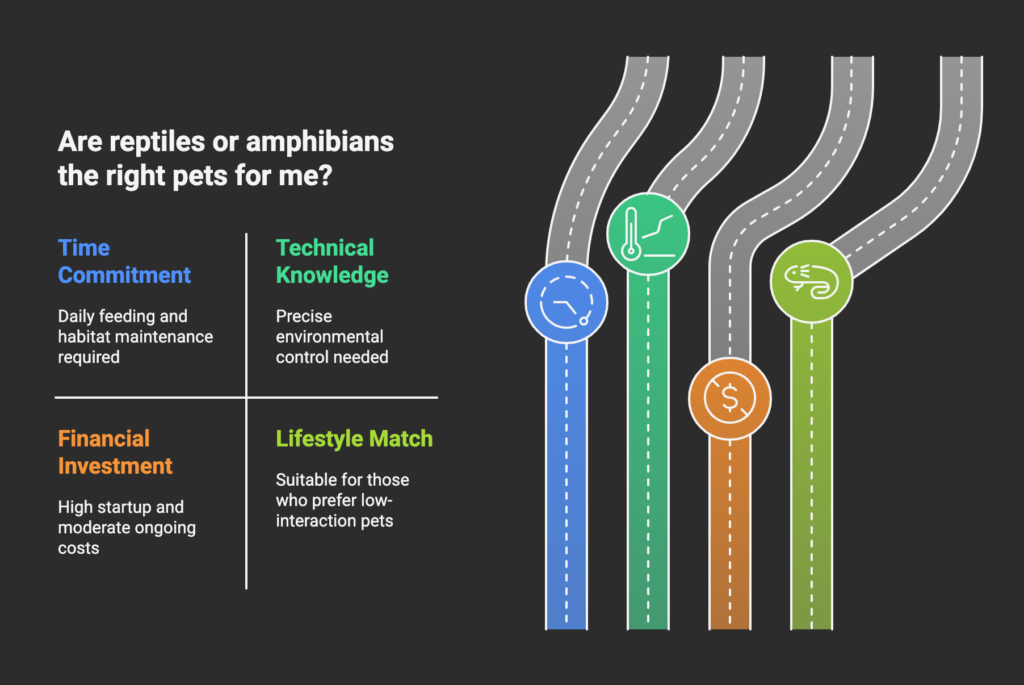
Birds: Intelligent and Social Flock Animals
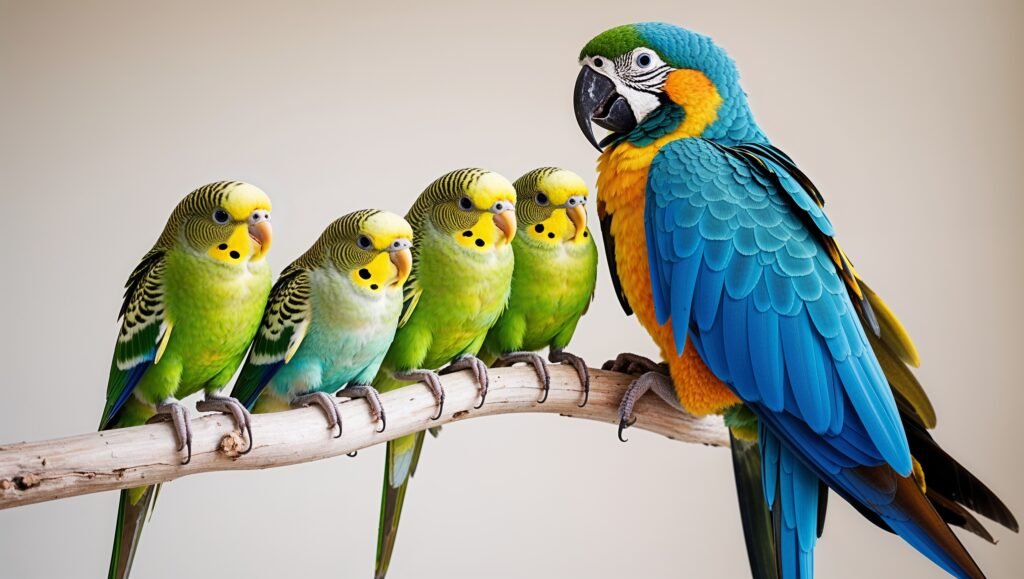
Birds range from small, relatively low-maintenance budgies to highly intelligent parrots with significant needs.
Time Commitment: All birds need daily interaction, with larger species requiring several hours of attention to remain behaviorally healthy.
Noise Considerations: Most birds vocalize, with larger species capable of significant volume. Consider your neighbors.
Lifespan: Smaller birds live 5-10 years, while larger parrots can live 30-70+ years, potentially outliving their owners.
Financial Investment: Cages and setup typically cost $200-$800, with annual costs of $200-$600.
Lifestyle Match: Smaller birds can work well for apartment dwellers who are home regularly. Larger parrots are best for very committed owners with stable lifestyles and living situations.
Fish: The Meditative Option
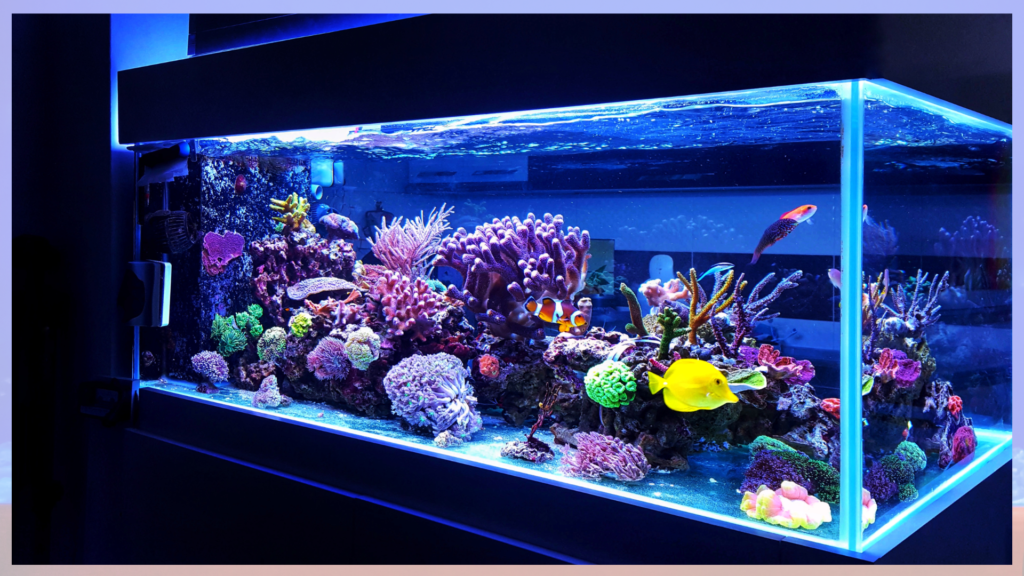
Fish keeping ranges from simple betta bowls to complex reef systems.
Time Commitment: Daily feeding and regular water changes, with more sophisticated setups requiring more monitoring.
Technical Knowledge: Success requires understanding nitrogen cycling, water chemistry, and species compatibility.
Financial Investment: Startup costs range widely ($50-$1,000+), with maintenance costs primarily for food, water treatments, and occasional equipment replacement.
Lifestyle Match: Good for those seeking living decor with meditative qualities rather than interactive companionship.
Matching Pets to Your Specific Lifestyle
For Busy Professionals
If you’re working long hours or frequently traveling:
- Best Options: Adult cats, especially pairs who can keep each other company; certain reptiles; fish
- Challenging Options: Puppies, high-energy dog breeds, birds
- Solutions: Consider pet sitters, dog walkers, or doggy daycare if you’re set on a more time-intensive pet
For Active Outdoorsy Types
If hiking, running, and adventure are your jam:
- Best Options: Athletic dog breeds like retrievers, herding dogs, or huskies
- Challenging Options: Most reptiles, delicate small mammals, most fish
- Consider: Look into adventure cats if you prefer felines – some cats can be trained to hike on harnesses
For Families with Young Children
Safety and temperament become paramount:
- Best Options: Gentle, patient dog breeds; larger, hardy cat breeds; guinea pigs (supervised)
- Challenging Options: Hamsters (fragile, nocturnal, may bite); birds that can nip; reptiles (salmonella concerns)
- Important Note: Always supervise young children with any pet, and teach proper handling from the start
For Seniors or Those with Limited Mobility
Finding companions that match your physical capabilities:
- Best Options: Adult cats, smaller low-energy dog breeds, fish, some bird species
- Challenging Options: Large powerful dogs, pets requiring complex habitats or frequent deep cleaning
- Consider: Many shelters have “seniors for seniors” programs with reduced adoption fees
For Those with Allergies
Not all pets trigger the same allergic responses:
- Potentially Better Options: Certain dog breeds (poodles, Bichons); reptiles; fish
- Note: No dog or cat breed is truly hypoallergenic, but some produce fewer allergens
- Consider: Spend time with the specific animal before adoption to test your reaction
Important Factors Beyond Lifestyle
Budget Realities
Be honest about what you can afford for:
- Quality food (the foundation of good health)
- Preventative veterinary care (annual exams, vaccinations)
- Emergency medical funds (accidents happen)
- Equipment, housing, toys, and enrichment
Lifespan Commitment
Are you ready for:
- A 10-15 year commitment (dogs, cats)
- A 20-70 year commitment (some parrot species)
- Or would a shorter-lived pet better match your current life stage?
Future Life Changes
Consider how these might impact pet ownership:
- Moving to new housing with different pet policies
- Relationship changes or family additions
- Career changes that affect time at home
Finding Your New Companion
Adoption vs. Purchase

I’ll share my bias upfront: adoption is usually the most rewarding route. Millions of wonderful pets wait in shelters nationwide, including purebreds and young animals if those are your preference.
Benefits of adoption include:
- Lower costs (typically $50-$350 including initial veterinary care)
- Support from rescue organizations
- The knowledge you’re saving a life
If you pursue a breeder for specific traits or health lineage, research thoroughly to avoid supporting puppy mills or irresponsible breeding practices.
Making the Match
- Visit potential pets multiple times before deciding
- Ask detailed questions about temperament and history
- Consider fostering first if the organization allows it
- Bring all family members who’ll interact with the pet
First-Time Pet Owner Tips
- Research before you adopt – Read books and credible websites specific to your chosen species
- Pet-proof your home – Address hazards before bringing your new friend home
- Find a veterinarian before bringing home your pet – Ask for recommendations and meet them first if possible
- Stock up on appropriate supplies – Have everything ready before your pet arrives
- Create a routine – Animals thrive on consistency
- Be patient during the adjustment period – It takes time for a pet to feel secure in a new environment
Conclusion
Choosing a pet is a big decision that impacts both your life and an animal’s welfare for years to come. By honestly assessing your lifestyle, researching thoroughly, and making a thoughtful choice, you’re setting yourself and your future pet up for a harmonious relationship.
Remember: there’s no such thing as a “perfect” pet – just as there’s no perfect human. The magic happens when you find the animal companion whose needs and personality complement your own lifestyle and capabilities.
Are you ready to take the next step in finding your ideal animal companion? Local shelters and rescue organizations are filled with potential matches waiting to meet you. Your perfect pet may be just a visit away.
Frequently Asked Questions
Q: How much does pet ownership typically cost annually? A: Annual costs vary widely by species and size. Dogs typically cost $500-$1,000 per year for basic care, cats around $300-$800, small mammals $200-$500, and fish from $100-$600 depending on tank size and complexity.
Q: What pets are best for people with allergies? A: While no mammal is truly hypoallergenic, some people with allergies do better with breeds like poodles, Bichons, and some terriers. Reptiles, fish, and certain bird species may be better options for those with severe allergies.
Q: How long should I expect to care for different types of pets? A: Dogs and cats typically live 10-15 years, rabbits 8-12 years, guinea pigs 5-7 years, smaller rodents 2-3 years, and some parrot species 30-70+ years. Research lifespan before committing.
Q: Can I have a dog if I work full-time? A: Yes, but you’ll need arrangements like dog walkers, doggy daycare, or a pet-sitting service. Adult dogs generally adapt better to time alone than puppies, and some breeds handle solitude better than others.
Q: What’s the best “starter pet” for a child? A: Rather than thinking in terms of “starter pets,” consider which animals align with your family’s ability to provide care and supervision. Guinea pigs are often good family pets as they’re sturdier than hamsters, generally friendly, and active during the day.

